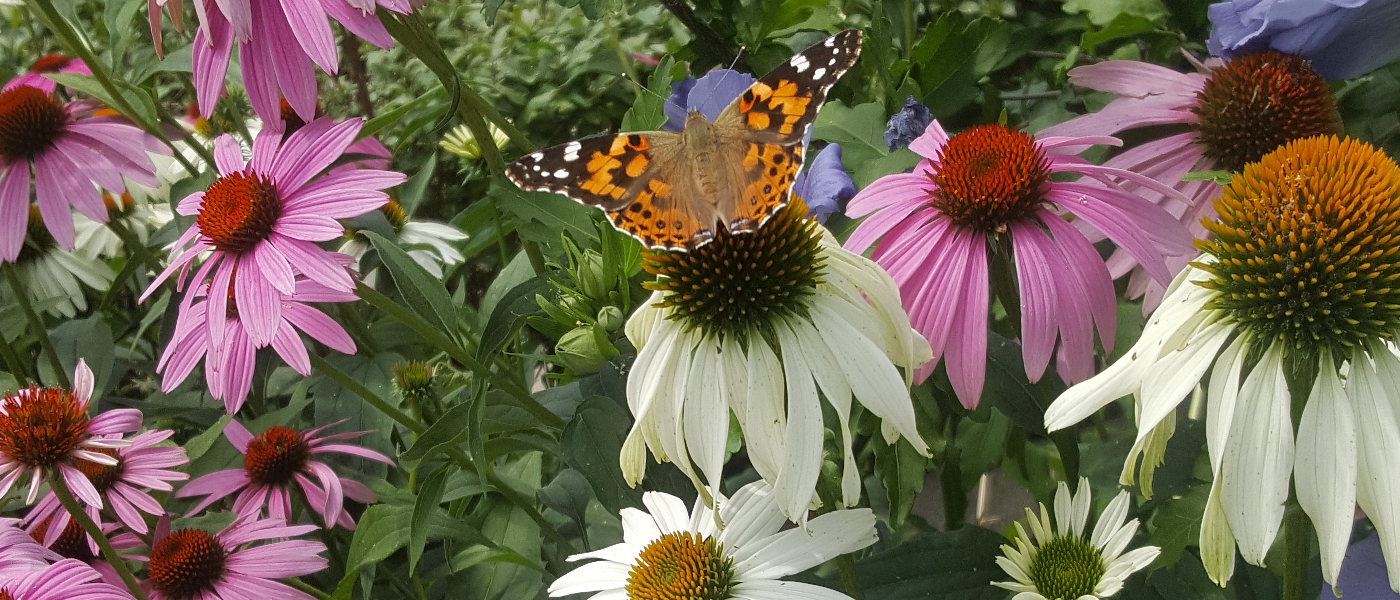Menu

Sun Garden Pack for New Gardeners
Announcing Starter Packs for New Gardeners: Full Sun
Are you new to gardening and just don't know what to choose? Welcome to the hobby. We're here to help. We have put together two starter packs of plants that are reliable, perform well in many conditions, and also help support our native insects.
With your Full Sun starter pack you'll get 8 plants, a sachet of root rescue, and an instruction sheet to help with planting and care questions.
For Sunny Gardens
If your garden gets at least 6 hours of unimpeded sun everyday, it is considered full sun. Just take a moment to consider the actual spot where your plant will go - make sure it isn't shaded by something before deciding it is a full sun garden. For instance, is there patio furniture next to the spot? Is there a tree that doesn't have leaves at the moment, but will at other times of year? Is there already a plant that is small in the spring, but will grow up later in the season, such as a large ornamental grass? Nope. OK. Good to go with full sun plants.
We've made a selection that has blooms from early summer through fall, and is in a primary colour palette (pink, blue, yellow) that will be easy to add to in future. The 5 plants that we have chosen for a full sun garden are:
Neon Stonecrop (Sedum spectabile)

This is a smaller, upright sedum with bright pink flowers in the fall. You will likely find bumble bees sleeping in it on cool fall mornings. These are the male bumble bees that never go back to their nest after they leave it. Sedum are very easy care. They do not need tending while they bloom, just cut off the finished stalks late in the fall or early in the spring. If you find that it gets so many stalks that it is falling open, that is your cue to divide it in the fall. (Package quantity 2, size 1 gallon)
Bumbleblue Sage (Salvia nemerosa)

Garden sage starts blooming in June, and will keep blooming all season long if you deadhead it. That simply means cutting off the flower once it is finished blooming. In the fall you can cut back the upright stalks, but leave the rosette of leaves at the bottom. Those are close to evergreen, and new growth will come from among them next spring. (Package quantity 2, size 1 gallon)
Kobold Blazing Star (Liatris spicata)

This is shorter version of the native Liatris spicata is also known as Gay Feather. It actually grows from a small bulb, and will self seed and grow new plants in your garden if you let it. Don't cut it back too soon or you'll be missing out on the fantastic red and burgundy fall display from the leaves. I leave mine all winter and cut it back in the spring because I want mine to spread. I am including this close cultivar of a native plant, because, although it isn't strictly native, they do tend to behave a bit better in our gardens. These are selected from naturally occurring variations in the species. (Package quantity 2, size 1 gallon)
Prairie Splendour Cone Flower (Echinacea purpurea)

This is a selection of a native flower. It is shorter than the wild version, and pinker. If you keep the dead flowers removed, it will keep blooming. But, towards the end of the season I leave them alone, so that they will peek out of the snow during winter and remind me where my garden is sleeping. Coneflowers are loved by many of our native insects and if you watch you'll see bees, butterflies, grasshoppers, and hover flies stop by for a snack. Small finches will also come and feast on the seeds. (Package quantity 1, size 1 gallon)
Sunny Seduction Yarrow (Achillea millefolium)

This is another selection of a native plant. The native, Achillea millefolium is white, spreads aggressively, and doesn't bloom for a particularly long time. However, the coloured versions of yarrow are much better behaved, and will bloom for a long time if you keep them deadheaded. In my garden I have fun watching the smallest bees nectaring on yarrow. If you have raspberries nearby, you probably also have the small carpenter bee, since they love to nest in old raspberry canes, and they also love to nectar on my yarrow. Don't worry, these aren't the bigger bully large carpenter bees. In the fall or spring you can cleanup any finished flower stalks, but like the salvia, leave the greenery at the bottom. If your clump of yarrow gets too big over time, you can easily divide it to put some somewhere else. (Package quantity 1, size 1 gallon)
How much space do these 8 perennials need?
Of course, that depends upon the type of plant. We have chosen a selection of plants that will need approximately 20 sq feet at maturity. Of course, when they arrive they will be small. You can expect your plants to take 2 to 3 years to fill in their space.
Can I make a substitution?
We are providing these collections of plants at a discount. We are not able to handle substitutions at this price.
What if one of the plants isn't available?
We do not anticipate any problem sourcing these plants. If we run into a problem, we will provide a different plant that is suitable for the same conditions.
Can I order other plants along with a pack?
Of course. Just put them in your cart.
I was told my soil is heavy clay. Will my plants be ok?
We have selected plants that aren't very picky about soil. However, if you have heavy clay, it is always a good idea to plant with some extra compost/manure. You can just throw a couple of handfuls on the soil after you dig your hold, and it will naturally mix in when you use it to plant. Take a look at the blog post about soils for more information.
I was told my soil is very sandy. Will my plants be ok?
We have selected plants that aren't very picky about soil. However, if you have sandy soil, it is always a good idea to plant with some extra compost/manure. You can just throw a couple of handfuls on the soil after you dig your hold, and it will naturally mix in when you use it to plant. Take a look at the blog post about soils for more information. Think you've read this somewhere before? Yes, the prescription for sandy soil is the same as the prescription for clay soil. Compost solves most soil issues.
You can purchase this package at our website : Plants in the City Sunny Garden Pack.
- Choosing a selection results in a full page refresh.

